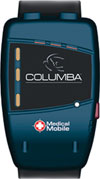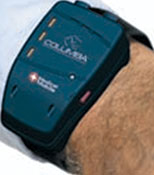
The healthcare sector is one of the future markets for portable GSM/GPRS/GPS solutions. There is now a range of such devices that constantly monitor patients' body functions such as pulse or blood pressure, transmitting the readings via GSM/GPRS to the doctor. These devices place high demands on the electronic components they contain: they must be both small and lightweight and use little electricity.
The Canadian firm Medical Intelligence Technologies (Medical Mobile in Europe) has developed a bracelet for patients with Alzheimer's and dementia, helping to locate affected patients quickly and easily when they are lost. The company used a combined GSM/GPRS/GPS module from the Italian M2M expert Telit Communications in its solution.
According to the European Alzheimer's Association, around 5,7 million Europeans suffered from various forms of dementia in 2000. Around 60% of patients with Alzheimer's and dementia occasionally go wandering off. They do not call for help and do not respond to calls. They are also disorientated and do not recognise dangerous situations. If they are not found quickly, their risk of death increases.
Mobile positioning system for patients with dementia
Medical Mobile has developed a special bracelet known as Columba. This is a positioning system with automatic alarm and options for audio communication. The 54 gram bracelet, about the size of a watch, helps prevent patients disappearing.

To do this, a relative or carer defines a secure zone on the device. This is determined individually and is usually the area in which the patient normally stays and is familiar with. The patient can then move around this zone freely, and the size of the area can be varied. The secure zone can, for example, include a friend's house, but the woods behind that house are out of bounds. If the patient leaves this pre-defined area, a warning signal is sent automatically via GSM/GPRS to a medical monitoring centre, which then notifies the responsible person in accordance with a pre-defined protocol, eg, via SMS. This stops valuable time being lost - something that can actually save the patient's life. Thanks to the A-GPS signal, the wearer of the bracelet can be pinpointed around the clock. With the integrated bi-directional voice module, the carer can communicate with the patient or people in his environment to check the alarm. This reduces the likelihood of a false alarm and thus the unnecessary and sometimes very expensive mobilisation of medical staff, is significantly reduced.

Columba also features an indoor/outdoor panic button, which can be deactivated if required. This allows the wearer to obtain direct communication with the medical call centre, for example if he or she is panicky or feeling unwell.
The bracelet is very user-friendly. And with the exception of the battery charger, no other medical equipment or applications are required.
From idea to product
The idea for this solution came from Louis Massicotte, CEO and co-founder of Medical Intelligence, whose mother suffered from Alzheimer's and frequently went wandering. He therefore went looking for a solution. The first challenge was to find a suitable GPS receiver with a sufficiently high level of sensitivity.
"Because the bracelet is worn next to the body, its sensitivity must be higher than with conventional GPS receivers," said Jean-François Montplaisir, CTO and co-founder of Medical Intelligence.
As a result, Medical Intelligence integrated A-GPS (assisted GPS) into the device. The company also tested a number of GSM modules.
"The modules need to meet common global safety standards such as the CE in Europe or the FCC in the USA," explained Montplaisir.
One of the other key criteria was the size of the module, since the entire application has to be worn on the arm. Because Columba needed to also be water-tight, a suitable GSM/GPRS module was also required.
Cooperation with Telit began in August 2002. "We were looking for a new M2M module, since we had been having problems with the module we had been using previously. We then tested the GM862-GPS from Telit and were very happy. Telit was also the first company that offered combined GSM/GPS modules like this," said Montplaisir.
Around one and a half years ago, the miniaturisation wave overtook electronic components. Since Telit's GM862-GPS module, measuring 44 x 44 x 6,7 mm and weighing around 23 grams was too large, the engineers opted for the embedded GE863-GPS module. This measures 41,4 x 31,4 x 3,6 mm and weighs just 9 grams.
The design of the Columba's power supply also turned out to be a major challenge. Medical Intelligence's aim was to achieve a battery life of at least one week - in spite of the considerable power consumption by the numerous electronic components. It thus developed a special battery charging unit whereby the bracelet could be recharged easily without a cable between the device and the wall.
The final task was to develop the infrastructure behind Columba. This includes a server and a global system that, for example, collects GPS information, together with the software for call centres. In June 2005, Columba was unveiled for the first time in Paris. "All in all, we are extremely satisfied with the development and with Telit's support. Of course, we have identified potential for optimisation with retrospect. This will help us operate more quickly on the next project," said Montplaisir.
GSM and GPRS in a single module
The core of Columba is the Telit GE863-GPS module, which combines GSM/GPRS and GPS in the smallest possible space. It is currently the smallest GPRS/GPS module on the market. Thanks to the innovative BGA (ball grid array) assembly concept, a direct connection is possible between the module and the base PCB. No plugs or cables are required - reducing size and weight.
One key component of the module is a SiRFstarIII 20-channel Singlechip from SiRF Technology. This latest-generation GPS receiver combines a complete digital A-GPS base-band processor with an RF front-end in a single chip. The receiver tracks up to 20 satellite signals simultaneously and therefore offers one of the shortest TTFF (time to first fix) times (1 s) outside buildings with only low signal strength. Unlike with the laborious sequential search processes in traditional GPS architectures, the SiRFstarIII architecture uses an equivalent of more than 200 000 correlators to search for all satellite frequencies and bit patterns simultaneously, a significant increase in performance over other architectures, which use several hundred to a few thousand correlators. SiRFstarIII technology also picks up very weak signals of just -159 dBm. Multimode SiRFLoc technology also quickly boosts missing or very weak signals mathematically using special algorithms. The Telit modules can therefore also detect signals that other conventional receivers cannot pick up.
Columba is presently the world's smallest device in the field of human telemetry. Yet Medical Intelligence is working constantly on optimising the bracelet further, building on the support it receives from Telit. Consequently, the company is planning to use the world's smallest GSM/GPRS module - the Telit GE864 - for its next version of Columba.
Promising prospects
According to estimates by the EU Commission, the number of over-60s in Europe will stand at around 37% in 2050, and with this there will be a constant rise in the number of patients with Alzheimer's and dementia. The market potential for Columba will therefore also increase. Medical Mobile markets Columba in France in cooperation with the pharmaceuticals distributor Dépôts Généraux Pharma in around 22 400 pharmacies. This business model deployed in France is now to be rolled out to other countries such as Spain, Denmark, the UK, the USA, Australia and Canada.
| Tel: | +27 21 555 8400 |
| Email: | [email protected] |
| www: | www.rfdesign.co.za |
| Articles: | More information and articles about RF Design |

© Technews Publishing (Pty) Ltd | All Rights Reserved